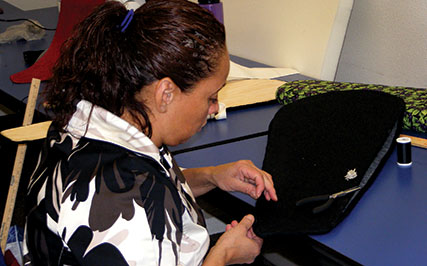Culture
Classes teach cradleboard making

By Savannah Ingram
Smoke Signals contributor
Tribal members and their families in both the Eugene and Portland satellite offices recently participated in a three-month cradleboard class taught by Carol Haskins and Colleen Payne.
During the classes, 24 students created 15 cradleboards and six doll cradleboards.
"This was a big class," Payne said. "We wanted the students to be able to learn how to make the boards using Pendleton or fabric of their choice to learn the process of how one style of cradleboard can be made."
Payne said that students worked in pairs or as families to create the finished projects.
The board bases were made by Payne's husband, Jerry, from a pattern that was originally obtained from the Warm Springs Tribe. The bows were purchased from Warm Springs, but learning how to finish the bows was taught in a different class.
Payne has created nine cradleboards for her grandchildren over the years, three of which were entered into a Pendleton Woolen Mills contest in 2011 that displayed one of the many uses for Pendleton fabric.
"You would typically see cradleboards like these used by Plains Tribes," Haskins said. "Traditionally, we would have carried infants in cradleboard baskets."
Cradleboards have been used by indigenous people around the world. They served the purpose of helping mothers care for their children while simultaneous working. Babies would be placed into the cradleboard and could be carried on the mother's back, on a horse or even hung from a tree to sway in the wind while the mother was working.
"Each cradleboard is so different and so beautiful in its own way," said Tribal Elder Debi Anderson, who participated in the Portland satellite office on Barbur Boulevard.
The first step of creating the cradleboards is to cover the board. Students then made pads to make the cradleboard comfortable. Once that was complete, Payne and Haskins helped each student customize the sides and hood for the board.
"Some of the boards were larger than the others and depending on the type of fabric used by the students, we helped them customize the sides and hood that worked with their fabric," Payne said.
Eric Bernando and Thomas Thacker worked on a board together. They said they wanted to learn how to make a cradleboard so they could give it away to a family.
"We spent hours in the fabric store looking for just the right fabric to go with our Pendleton fabric," Thacker said.
Bernando and Thacker cut, sewed and bled creating the cradleboard. Thacker twined the rope used to tie the baby into the cradleboard using stinging nettle that he had collected. They also decorated the hood with large shell buttons, dentalium and glass beads.
"It was a lot of work," Bernando said, "but I really enjoyed putting it together for someone."
"We know there are other ways to create cradleboards," Payne said. "We just taught one way to making them."
"We can't wait to see them fully completed with the bows," Haskins said.
